Playing with Knowledge – Part 13
|
|
Fachmännisch spielen – Teil 13
|
- We are almost at the end of our list of leadership qualities. We recall that the reason for starting all this was that we want to become good friends and playmates for our horses – and that this requires leadership, because a flight animal who is worried about his safety, will naturally not be in a playful mood. So he needs to feel safe with us – and if we fulfil points one to ten on the list, he will.
- But for playing there is one more important ingredient missing! And point 11 sounds easier than it is!
11. Be interesting and fun !
- If, as I hope you will, you engage on the path of playing the 100 Training Games I suggest in “From Leading to Liberty”, you will soon find out that, although carrots are always welcome, they are not quite sufficient to interest your horse deeply enough to want to actively play with you. Remember that we are talking LIBERTY, which means, your horse has the freedom to accept your carrot and then promptly leave you again for the other end of the paddock!
|
|
- Nun sind wir fast am Ende unserer Liste der Führerqualitäten. Wir erinnern uns, daß wir mit all dem angefangen haben, weil wir gute Freunde und Spielkameraden für unsere Pferde werden wollen – und daß dies Führungsqualitäten voraussetzt, da ein Fluchttier, welches sich um seine Sicherheit Sorgen machen muß, natürlich nicht in Spiellaune sein wird. Daher muß es sich mit uns sicher fühlen können – und wenn wir die Punkte 1 bis 10 erfüllen, kann es das.
- Aber für echtes Spiel fehlt noch eine Zutat! Und Punkt 11 klingt einfacher als es ist!
11. Seien Sie interessant und amüsant!
- Wenn Sie, wie ich hoffe, den Weg der 100 Trainingsspiele, die ich in “From Leading to Liberty” beschreibe, beschreiten, werden Sie schnell herausfinden, daß Möhren, obwohl immer willkommen, nicht unbedingt genug sind, um Ihr Pferd genug zu interessieren auch wirklich aktiv mit Ihnen zu spielen. Da wir ja in FREIHEIT spielen, hat Ihr Pferd auch die Freiheit Ihre Möhre anzunehmen, Sie danach aber prompt wieder zu verlassen!
|
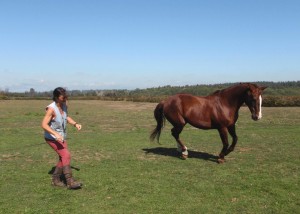 We canter in Sync – body language is clear, horse fully focused! |
How do you make your horse stick around?
- Obviously, if your horse is not curious about the exiting thing to come next, he will be much less motivated to do so. Again the difficulty lies in the fact that we may be mistaken about what interests our horse. We humanize too much – and often we grossly underestimate their intelligence!
Feeling pressured never interests a horse!
- After the initial respect training and the first establishment of a meaningful communication (correct body language on your part) you will suggest a game to your horse. You will use your intelligence and make a reasonable choice among the offered games – you do NOT have to play them in the sequence of the book! But when the chosen one tells you under “recommendations” that you should prepare him for this game by other prep-exercises, then there is usually a good reason for that. Because one of the main criteria of being interesting is to never over-challenge your horse! Attainment of success must be within reach in order to fascinate the horse to participate! And how do we know whether the horse feels that he can achieve the goal? In part 08 we learned to be observant – now let’s find out what the horse’s answer is to our suggestions!
|
|
Was tun, damit es bei Ihnen bleibt?
- Wenn Ihr Pferd nicht auf das nächste Ereignis neugierig ist, wird es natürlich weniger zum Bleiben neigen! Die Schwierigkeit liegt wieder in der Tatsache, daß wir vielleicht mißverstehen, was unser Pferd interessiert. Wir vermenschlichen zuviel und unterschätzen auch oft sehr ihre Intelligenz!
Unter Druck gesetzt zu werden interessiert ein Pferd nie!
- Nach dem anfänglichen Respektstraining und der Einführung einer bedeutungsvollen Kommunikation (korrekte Körpersprache unsererseits) werden Sie Ihrem Pferd ein Spiel vorschlagen. Sie werden eine intelligente und vernünftige Wahl unter den angebotenen Spielen treffen – Sie müssen diese NICHT in der selben Abfolge wie im Buch spielen! Nur, wenn das gewählte Spiel unter “recommendations” erst andere Vorübungen vorschlägt, gibt es stichhaltige Gründe dafür. Denn ein Hauptkriterion des Interessant-Seins ist, daß man sein Pferd nicht überfordert! Es muß möglich sein, einen Erfolg zu erreichen, damit das Pferd am Mitmachen Lust hat! Und wie wissen wir, daß es meint diesen Erfolg erreichen zu können? Im Teil 08 haben wir gelernt unser Pferd zu beobachten – nun können wir sehen, was seine Antwort auf unseren Vorschlag ist!
|
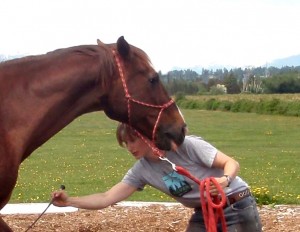 “Airplane” ears and tongue stuck out show he is at a loss |
Help, Explain and Motivate:
- I suggest the approach of H.E.M., which always works best. Normally we start by explaining the exercise – at first often on the loose rope. If the horse pays attention – praise! For each tiny learning step praise! Keep the session short.
What if the horse shows no interest?
- This can have various reasons of course. (We presuppose here that by now he does feel safe with you)
- 1) You did not fulfill other instinctual needs first (grass, choice of time etc)
- 2) He does not feel safe in the surrounding you chose
- 3) The game over-challenges your buddy (remember from earlier blogs the pictures of King in front of the tyres?)
|
|
Helfen, Erklären und Motivieren:
- Mein Vorschlag ist nach meiner H.E.M. Methode vorzugehen, die immer am besten funktioniert. Normalerweise fangen wir mit den Erklären einer Übung an – oft noch am losen Seil. Wenn das Pferd aufpaßt – loben! Jeder kleine Lernschritt wird gelobt! Halten Sie die Trainingseinheit kurz.
Was, wenn das Pferd kein Interesse zeigt?
- Das kann natürlich verschiedene Gründe haben. (Wir setzen hier voraus, daß es sich mit Ihnen schon sicher fühlt)
- 1) Seine instinktbedingten anderen Bedürfnisse sind noch nicht befriedigt (Fressen, Wahl der Zeit etc)
- 2) Es fühlt sich in der gewählten Umgebung unsicher
- 3) Das Spiel überfordert Ihren Partner (erinnern sie sich an die Fotos von King vor den Reifen?)
|
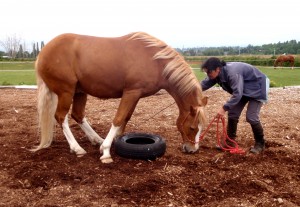 King says: “I’d rather die! I simply can’t !!” |
- 4) He wants to play something else!
- Point 1 was discussed earlier at length. Point 2 you will recognize by him shying away from certain areas (those ghosts in the corners!), by fidgeting and a general lack of concentration. You must go and explore – you learned earlier how to knowledgeably lead that exploration so your horse can feel safe with you!
- Point 3: if the game over-challenges him, he will show anxiety which is focused on the object or activity which you are offering (rather than looking at the surroundings). If he is willing to engage in your game anyway, you may proceed by offer HELP, as discussed in the H.E.M. series. Signals that he needs help are visible in his body language – sticking out the tongue, for example, suggests confusion. Ears dropped sideways with the hollow part pointing toward the body signals likewise insecure questioning. Even flattened ears can signal a stressed-out scream for help!
|
|
- 4) Es will was anderes spielen!
- Punkt 1 wurde früher schon gründlich besprochen. Punkt 2 erkennen Sie am Wegscheuen vor bestimmten Gegenden (die Gespenster in den Ecken!), dann müssen Sie erkunden gehen – Sie haben ja nun gelernt, wie man das fachmännisch anleitet, so daß Ihr Pferd sich mit Ihnen sicher fühlen kann.
- Punkt 3: wenn das Spiel es überfordert, wird es eine Ängstlichkeit zeigen, die sich auf das angebotene Objekt oder die Aktivität selbst (anstatt auf die Umgebung) richtet. Wenn es sich trotzdem auf das Spiel einläßt, kann man mit HELFEN (wie in der H.E.M. Serie besprochen) weitermachen. Daß es Hilfe braucht, wird es mit Körpersprache ausdrücken – z.B. die Zunge herausstrecken zeigt Unsicherheit. Seitlich abgestellte Ohren mit nach hinten-unten gedrehten Muscheln sind verunsichert-fragend. Sogar angelegte Ohren können ein gestreßter Hilfeschrei sein!
|
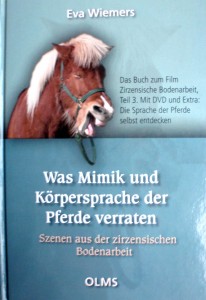 |
If you read German:
- Perhaps I will excerpt in a later Blog series some of what I have learned from this excellent book – but if you read German – GET IT !! It is called “Was Mimik und Körpersprache der Pferde verraten“ by Eva Wiemers, Olms Verlag. Apart from offering a world of information about conversations between horses in the herd (which is further demonstrated in an included wonderful DVD) it is also written in a very entertaining way.
- Or at least read the “Understanding your Horse” series.
- So if, after learning to understand the horse’s body language, you see that your suggested game is stressing your horse out – change your plan and offer him something else instead, something that makes him feel good about himself.
- The method of Help, Explain and Motivate (read the H.E.M. Blogs series) will teach you to discern more and more what a specific situation calls for.
Let your horse take some decisions too!
- Point 4: if your horse wants to play something else, he will let you know! And you must see and understand the suggestion! The more you play, the more suggestions you will get from your horse. In real play you will accept and praise a lot of them – though you are not obliged to go along with all of them. Play is an interchange of suggestions – every partner has the right to propose, but also the right to reject. In terms of motivation it is always positive to go along with what your horse suggests – even if only for a brief time span. It makes him feel important! A freely offered Spanish step or proud rearing shows high motivation!
|
|
Für deutsche Leser:
- Vielleicht komme ich später mal dazu einiges, was ich aus diesem exzellenten Buch gelernt habe, weiter zu besprechen – aber kaufen Sie es!! Es heißt “Was Mimik und Körpersprache der Pferde verraten“ von Eva Wiemers, Olms Verlag. Es bietet eine Menge Information über Unterhaltungen zwischen Pferden in der Herde (weiter verdeutlicht durch eine beigelegte DVD) und ist auch sehr amüsant geschrieben.
- Lesen Sie zumindest die Serie “Ihr Pferd verstehen”.
- Wenn Sie also nach Erlernen seiner Körpersprache erkennen, daß das vorgeschlagene Spiel Ihr Pferd streßt, ann ändern Sie Ihren Plan und bieten etwas anderes an – etwas, das ihm Wohlgefühl vermittelt.
- Die Methode des „Helfen, Erklären und Motivieren“ (lesen Sie die H.E.M. Serie noch einmal) wird sie schrittweise dazu bringen, immer besser zu erkennen, was die spezielle Situation erfordert.
Lassen Sie Ihr Pferd Entscheidungen treffen!
- Punkt 4: wenn Ihr Pferd etwas anderes spielen will, wird es Sie das wissen lassen! Sehen und verstehen Sie den Vorschlag! Je mehr Sie spielen, desto mehr Vorschläge werden Sie von Ihrem Pferd bekommen. In echtem Spiel werden Sie viele davon annehmen und loben – obwohl Sie nicht bei allen mitmachen müssen. Spiel ist ein Austausch von Vorschlägen – jeder Spielpartner hat das Recht vorzuschlagen, aber auch abzulehnen. Für die Motivation ist es immer gut mit dem, was Ihr Pferd vorschlägt, mitzumachen – wenn auch nur kurz. Dann fühlt es sich wichtig! Ein freiwillig angebotener spanischer Schritt oder ein Steigen zeigt hohe Motivation!
|
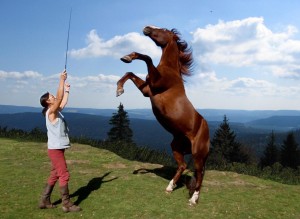 Peter well over 30, still proud to rear! |
Variety is the spice of life!
- In my book you have 100 games to choose from, which should keep you busy for a while. By the time your horse and you master those, you will both be so proficient that developing more presents no problem! Your horse will proudly show you what he can invent!
- Playing is about partnership, not obedience or performance. So it involves a lot of trial and error. Don’t ever feel ridiculous – there is no failing!
- Jubilate and laugh a lot! If playing with your horse doesn’t make you happy too, you are not on the right track.
This concludes our list of leadership qualities, which comprised eleven points:
- Be calm
- Be observant, know the horse’s body language and what he is saying
- Be knowledgeable about things HE finds important
- Establish routines
- Show the right reactions
- Be determined and firm
- Be a true leader, not over-protective
- Give him courage – don’t just de-sensitize him
- Be reasonable
- Understand him and let him live out his instincts
- Be interesting
- Pin this list above your mirror at home and read it before you go to the stable – remember: when things go wrong, it is always the fault of the trainer and very often it results from a lack of leadership!
We will continue with more information about Knowledgeable Playing in the next Blog! Read on!!
|
|
Abwechslung ist das halbe Leben!
- In meinem Buch haben Sie 100 Spiele zur Auswahl, das sollte Sie eine Weile beschäftigt halten. Bis Ihr Pferd und Sie diese alle gemeistert haben, sind sie beide so erfahren, daß das Entwickeln neuer Spiele kein Problem darstellt! Ihr Pferd wird stolz zeigen, was es alles erfinden kann!
- Beim Spielen dreht es sich um Partnerschaft, nicht Gehorsam oder Leistung. Es beinhaltet eine Menge empirisches Ausprobieren. Fühlen Sie sich nie lächerlich – es gibt kein Versagen!
- Jubilieren und lachen Sie viel! Wenn mit Ihrem Pferd Spielen Sie nicht auch glücklich macht, dann sind Sie auf der falschen Spur.
Hiermit beenden wir unsere Liste der Führerqualitäten, die elf Punkte umschloß:
- Ruhig bleiben
- Gut beobachten, die Körpersprache des Pferdes verstehen
- Kenntnis haben von Dingen, die IHM wichtig sind
- Gute Routine einführen
- Die richtigen Reaktionen zeigen
- Entschlossen und bestimmt sein
- Ein guter, aber nicht überbeschützender Anführer sein
- Ihm Mut machen – es nicht nur desensitivieren
- Vernünftig sein
- Die Pferde ihre Instinkte ausleben lassen.
- Interessant sein
- Kleben sie diese Liste auf Ihren Spiegel und lesen Sie sie bevor sie in den Stall fahren – erinnern Sie sich: wenn etwas nicht klappt, ist es immer der Fehler des Trainers, und sehr oft resultiert es aus fehlenden Führerqualitäten!
Wir fahren fort mit weiteren Informationen über fachmännisches Spielen – lesen Sie weiter! |

